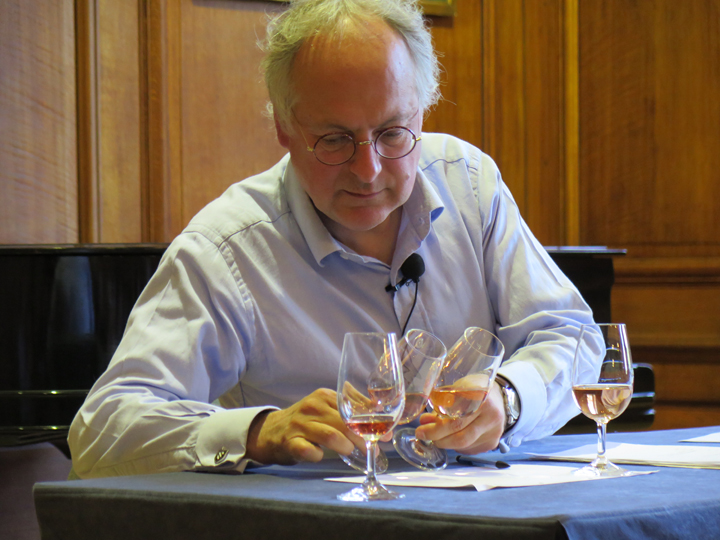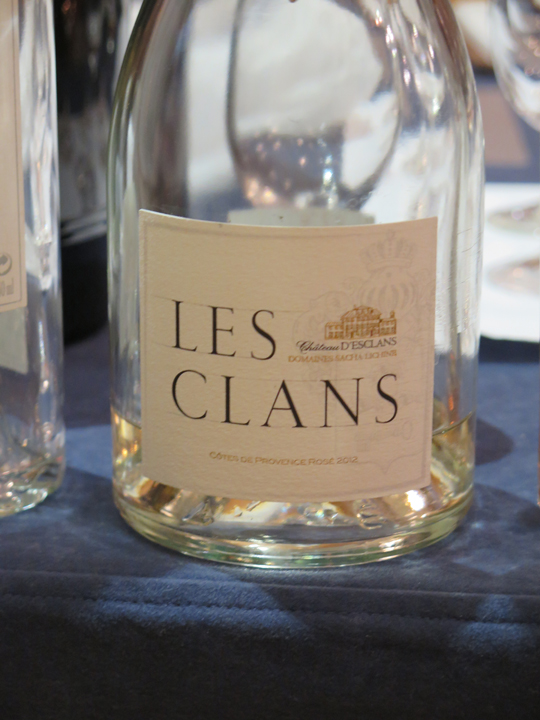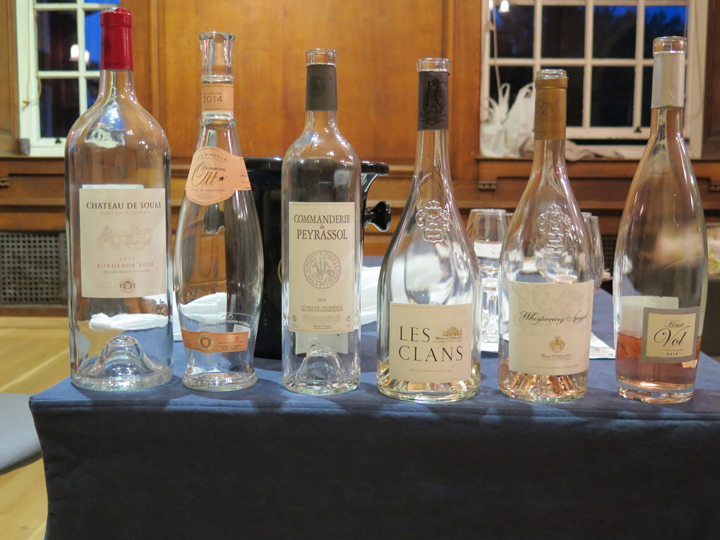For his presentation to Oxford Wine Club about ‘rethinking rosé‘, Jonathan focussed on two major themes. Firstly, that of rosé wines and age: should rosé always be drunk young, will it develop complexity with age? Secondly, he asked us to consider whether rosé could aspire to greatness or was it just a simple pleasurable drink?
 Jonathan outlined the upsurge, since 2003, in the popularity and consumption of rosé wines in the UK. The days of only having a choice between uninspiring Mateus and Anjou rosés are well and truly behind us, with many more rosés now on the market. Ten years ago rosé wines comprised less than 1% of all UK sales. Currently, the figure is in the region of 10%. Rosé is now drunk throughout the year and not uniquely during the warm summer months.
Jonathan outlined the upsurge, since 2003, in the popularity and consumption of rosé wines in the UK. The days of only having a choice between uninspiring Mateus and Anjou rosés are well and truly behind us, with many more rosés now on the market. Ten years ago rosé wines comprised less than 1% of all UK sales. Currently, the figure is in the region of 10%. Rosé is now drunk throughout the year and not uniquely during the warm summer months.
The presentation consisted of two parts. We were firstly asked to taste 3 vintages of rosés from the well-respected Château de Sours (Bordeaux): 2012, 2013 and 2014. The second part of the tasting was a ‘blind’ tasting of 4 Côtes de Provence rosés and 1 from Languedoc.
The late Auberon Waugh described Château de Sours as “probably the greatest rosé in the world.” The 3 vintages we tasted had slightly differing blends of Merlot, Cabernet Franc and Cabernet Sauvignon, determined by the weather characteristics of the growing and harvesting periods. However, they were all Merlot dominated (the 2014 was 100% Merlot) and all experienced identical vinification processes. After picking, the grapes were gently crushed, underwent cold maceration for 6-8 hours and then a period of cool fermentation. All were at 12.5% and dry.
 Each of the 3 vintages displayed marked differences, the 2014 showing the most vibrant and deepest pink colour, with characteristic pear drop, banana and fermentation aromas on the nose. On the palate, there was a juicy, fruit plumpness and much less acidity than the 2 earlier vintages. Both the 2013 and 2012 had lost much of the youthful pinkness and were less aromatic. The 2012 in particular had no obvious fruit on the nose, but was clean and vinous.
Each of the 3 vintages displayed marked differences, the 2014 showing the most vibrant and deepest pink colour, with characteristic pear drop, banana and fermentation aromas on the nose. On the palate, there was a juicy, fruit plumpness and much less acidity than the 2 earlier vintages. Both the 2013 and 2012 had lost much of the youthful pinkness and were less aromatic. The 2012 in particular had no obvious fruit on the nose, but was clean and vinous.
The second flight of 5 wines were all from 2014, Grenache dominated and at 14%. They ranged in price from £6.66 to the second most expensive rosé in the world, at £45. Only one wine displayed a vibrant pink colour, the others having very pale even yellow hues. After tasting the wines, club members were asked to decide upon their favourite and to determine which was the most expensive.
The favourite wine of the majority of those present was the 2014 Clos Mireille from Domaines Ott vineyards on the Mediterranean coast. A blend of 70% Grenache, 20% Cinsault and 10% Syrah the wine had a firm structure in the mouth, balanced by crispness with fruity notes and a touch of grapefruit and gooseberries, more suggestive of a Sauvignon Blanc than a Grenache dominated wine. At £25, this was the second most expensive of the 5 wines.
 The £45 wine was Les Clans, the second wine of the Domaines Lichine Caves d’Esclans vineyards (Château d’Esclans is their premier wine). Made primarily from Grenache with some Rolle (Vermentino) grapes ‘harvested at sunrise to noon’ and fermented in 600 litre new oak barrels, with a limited production of 20,000 bottles per year. The very pale wine is aromatic, evocative of ‘roses, peaches and strawberries’ with a long finish. According to Jonathan it is reminiscent of ‘old fashioned white Rioja’ and perfect if ‘you are on the pull!”
The £45 wine was Les Clans, the second wine of the Domaines Lichine Caves d’Esclans vineyards (Château d’Esclans is their premier wine). Made primarily from Grenache with some Rolle (Vermentino) grapes ‘harvested at sunrise to noon’ and fermented in 600 litre new oak barrels, with a limited production of 20,000 bottles per year. The very pale wine is aromatic, evocative of ‘roses, peaches and strawberries’ with a long finish. According to Jonathan it is reminiscent of ‘old fashioned white Rioja’ and perfect if ‘you are on the pull!”
In comparison we also tasted another wine from the d’Esclans stable: Whispering Angel. This wine is made from Grenache, Rolle and Cinsault grapes harvested in the D’Esclans domains as well as from vineyards in the surrounding region. Over 2 million bottles are produced each year. A light salmon colour, this wine did have some strawberry and raspberry notes, but was considered to be ‘not very good’.
The only wine with a pronounced, deep pink colour was the Haut Vol, a Vin de Pays d’Oc. Made from a blend of Grenache and Carignan with a fruity nose, this wine is a characteristically easy drinking summer rosé. At £6.66 (from Majestic) this was the cheapest wine of the tasting and with its freshness was considered to be good value.
 A second wine procured from Majestic [£11,00), was the Commanderie de Peyrassol from the Peyrassol vineyards on the slopes of the Massif des Maures in the Var. Made from a blend of Carignan, Cinsault, Grenache noir and Syrah grapes harvested from vines with an average age of 25, this wine was light, fresh, with some fruit notes, but generally considered to be ‘a bit dull’.
A second wine procured from Majestic [£11,00), was the Commanderie de Peyrassol from the Peyrassol vineyards on the slopes of the Massif des Maures in the Var. Made from a blend of Carignan, Cinsault, Grenache noir and Syrah grapes harvested from vines with an average age of 25, this wine was light, fresh, with some fruit notes, but generally considered to be ‘a bit dull’.
In conclusion to the tasting a range of opinions surfaced regarding the themes highlighted by Jonathan at the beginning. Members were divided in their opinions about the 3 wines from Château de Sours, although consensus seemed to be that rosé wines should indeed be drunk younger rather than older. Regarding the question of whether rosé wines could ‘aspire to greatness’ … the discussion continues!
Chris Blakey
24/05/2015.